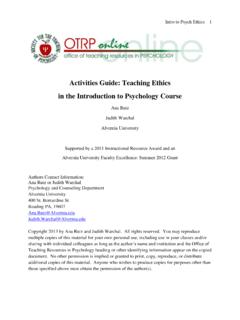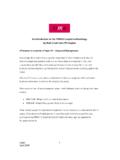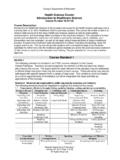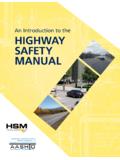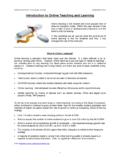Transcription of Introduction to Knowledge Management - ASEAN Foundation
1 Introduction to Knowledge Management Copyright 2008. ASEAN Foundation Jl Sam Ratulangi No. 2, Menteng Jakarta 10350 Indonesia Tel Nos.: (62 21) 3192 4833, 3192 4828. Email: Website: All rights reserved. Permission is necessary to reprint or reproduce any part of this book for commercial purposes, but permission is granted to reprint material for instructional and research purposes and other free publications. Please acknowledge source including copyright notice on reprint. Mention of corporations, brand names and proprietary technologies and equipment in this book does not imply endorsement by the author or the ASEAN Foundation . Published (2008) by the ASEAN Foundation , Jakarta, Indonesia. ISBN No. 978 - 979 - 19684 - 0 - 9.
2 Book Design by Kinetika ii ACKNOWLEDGEMENT. The preparation of this book was made possible by a grant from the National Academy of Science and Technology. For this reason, I would like to express my heartfelt thanks to the President of the Academy, Dr. Emil Q. Javier, and the Executive Director, Ms. Luningning Samarita, for their kind cooperation and generous assistance. Its publication is made possible through funds made available by the Government of Japan from the Japan- ASEAN Solidarity Fund and by the ASEAN Foundation . I would like to thank Ms. Mitsuko Ito of the Embassy of Japan in Indonesia and Ms. Renelle Ivy Adan, Ms. Nyla Grace Prieto and Mr. Ade Cahyadi of the ASEAN Foundation for their kind assistance to make this possible.
3 If this book were to have a co-author, it would be my wife who carefully prepared and meticulously edited, cleaned up and enhanced all the tables, charts, figures and boxes contained in this book. She conceptualized, designed and prepared the final layout of this book and reviewed the final draft prior to printing. I am greatly indebted to her. Thus I should like to dedicate this book to my loving wife and able partner Jean. Dr. F. A. Uriarte, Jr. Executive Director ASEAN Foundation iii FOREWORD. This book is not for Knowledge Management experts and practitioners. It is for those who have no previous background on Knowledge Management but would like to know something about the subject. The purpose of this book is to provide an Introduction to the various elements of Knowledge Management .
4 It is meant for a wide audience of readers interested in gaining some understanding of the basics of Knowledge Management . These include the professionals in the private sector, the managers of corporations, the business executives, as well as the government officials at various levels who may have Management , technical or engineering background but no exposure yet to Knowledge Management . This book is meant to be their first book on Knowledge Management . This book has six chapters. The first chapter introduces the concept of Knowledge as differentiated from data and information. There is no attempt to examine the various theories and postulates about how Knowledge is created or generated. The aim is merely to distinguish data from information, and information from Knowledge , and to introduce the reader to the two types of Knowledge that are of importance to Knowledge Management .
5 The second chapter defines what Knowledge Management is by discussing the four pillars of Knowledge Management . The aim is merely to give a glimpse of Knowledge Management without having to go too deeply into the technical details and the technologies that enable the implementation of Knowledge Management . The third chapter deals with the brief history of Knowledge Management , how the discipline developed in the 1970s, 1980s and 1990s. Short descriptions of the first and second generations of Knowledge Management initiatives are provided to give the reader an indication of how the practice of Knowledge Management developed. The fourth chapter deals with the elements of Knowledge Management . It provides an Introduction to Knowledge creation and capture, Knowledge sharing and enrichment, information storage and retrieval, and iv Knowledge dissemination.
6 As a mere Introduction , the section on information storage and retrieval does not cover the various technologies that enable and facilitate information storage and retrieval. The fifth chapter is about Knowledge Management tools. No attempt is made to describe in detail the various technologies for document Management , developing an enterprise portal, preparing Knowledge maps and sharing lessons learned. The reader is merely introduced to the concepts and given a few selected examples of these tools. The sixth and final chapter provides a simple, step-by-step guide towards the implementation of Knowledge Management . The purpose is not to enable the reader to implement a Knowledge Management initiative, but to understand the steps that may be taken by a Knowledge Management expert that his or her organization may retain to implement a Knowledge Management initiative.
7 V vi TABLE OF CONTENTS Page Foreword iv Table of Contents vii List of Boxes, Figures and Tables viii Chapter 1 Concept of Knowledge 1. Chapter 2 Defining Knowledge Management 13. Chapter 3 History of Knowledge Management 32. Chapter 4 Elements of Knowledge Management 45. Chapter 5 Knowledge Management Tools 66 Chapter 6 Implementation of Knowledge Management 93. Annex 1 Knowledge Mapping at the Philippine 114. Department of Health Annex 2 Cases in KM Failure 126. Annex 3 Knowledge Management Profiles 133. Annex 4 A Decade of Knowledge Generation and Sharing: 155 Projects Funded by the Japan- ASEAN Solidarity Fund References 163. The ASEAN Foundation and Japan- ASEAN Solidarity Fund 167. vii LIST OF BOXES Page Box An example: data, information and Knowledge 3.
8 Box Definitions of Knowledge 10. Box Why do we have to manage Knowledge ? 18. Box Definitions of Knowledge Management 27. Box Banking on Knowledge 33. Box Development of Knowledge Management at Microsoft 35. Box First and second generation Knowledge Management 39. Box People over technology: usefulness of technology decreases as complexity increases 42. Box Implementing the Knowledge Bank: Chronology 43. Box Implementing the Knowledge Bank: Level of Difficulty 43. Box Implementing the Knowledge Bank: Results 44. Box The Role of XML 49. Box Live Meetings at Microsoft 51. Box The Value of Communities of Practice: An Example for the World Bank 57. Box The Productivity Challenge: A Closer Look 61. Box Initiative for Knowledge Sharing and Dissemination 65.
9 Box Document Management : KM Starting Point 69. Box Key Enterprise Portal Basic Functions 72. Box A Case Study of the Performance of an Enterprise Portal 73. Box Example of Expert Directory 79. Box KMApps and Mapview 81. Box Groupware as Collaboration Tool 83. Box Communities of Practice 89. Box A Framework for Implementing Knowledge Management 94. Box Challenges of KM Implementation 98. Box Phased Implementation of KM at Asian Development Bank 104. viii Box Microsoft's Six Quick Ways to Implement Knowledge Management 108. Box The Human Element: KM's Secret Ingredient 112. LIST OF FIGURES Page Figure Conceptual Progression from Data to Knowledge 2. Figure Spiral of Organizational Knowledge Creation 7.
10 Figure Primary repositories of an organization's Knowledge 9. Figure Knowledge Capture and Sharing 46. Figure Stages of Development of Communities of Practice 53. Figure Communities of Practice are Linked to Organizational Performance Through the Dimensions of Social Capital 55. LIST OF TABLE Page Table What is KM? 13. Table Technology Appropriate to Knowledge Management Approach 21. Table Summary of Study of Characteristics of Communities of Practice 59. ix x CHAPTER 1. Concept of Knowledge Knowledge is increasingly being recognized as the new strategic imperative of organizations. The most established paradigm is that Knowledge is power. Therefore, one has to hoard it, keep it to oneself to maintain an advantage.

